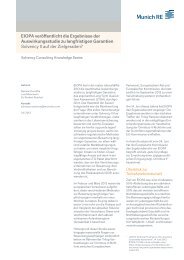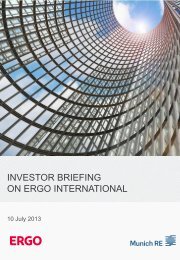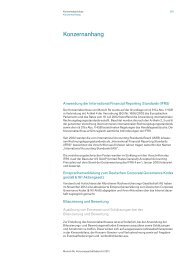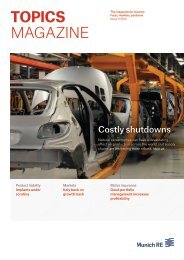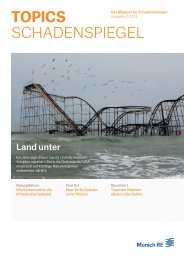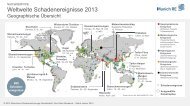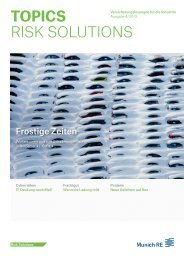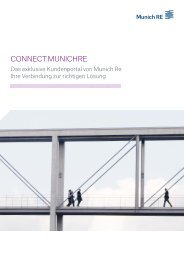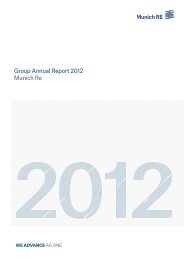Munich Re Group Annual Report 2006 (PDF, 1.8
Munich Re Group Annual Report 2006 (PDF, 1.8
Munich Re Group Annual Report 2006 (PDF, 1.8
You also want an ePaper? Increase the reach of your titles
YUMPU automatically turns print PDFs into web optimized ePapers that Google loves.
<strong>Munich</strong> <strong>Re</strong> <strong>Group</strong> <strong>Annual</strong> <strong>Re</strong>port <strong>2006</strong><br />
The changes in market value shown in the table can only<br />
be taken as rough indicators of actual market value losses<br />
that might occur in the future, as they do not consider any<br />
counteractive measures. Moreover, the effects on the<br />
<strong>Group</strong>’s annual result and equity would be reduced as a<br />
consequence of policyholders’ shares and the tax implications.<br />
More importantly, we consider the economic effects of<br />
such changes on the difference between asset and liability<br />
values to be the most reliable indicator of our asset-liability<br />
mismatch. As an illustration, in the reinsurance segment<br />
the effective duration (interest-rate sensitivity) of our<br />
assets is 5.7 years, whilst the effective duration of our<br />
liabilities is 5.5 years, showing that on an economic basis,<br />
we are broadly immunised from the effects of interest-rate<br />
rises and falls. In the primary life segment, interest-rate<br />
rises are – economically speaking – positive for us regarding<br />
interest-rate guarantees, as these guarantees then<br />
move further “out of the money”. The extensive swaption<br />
programme we put in place in 2005 and further supplemented<br />
in <strong>2006</strong> means that we are to a large extent protected<br />
against interest-rate falls concerning the guarantees,<br />
albeit at some cost. However, our policyholders still<br />
benefit from interest-rate rises when reinvestments can be<br />
made at superior conditions.<br />
Credit risks<br />
Risk management processes<br />
Our internal risk model also takes account of a wide range<br />
of specific drivers that impact on our credit exposure.<br />
Credit risks emanating from the insurance and investment<br />
sides of the balance sheet are considered. On the insurance<br />
side, we model trade credit, surety and bonding,<br />
credit enhancement, and political risks. We also take into<br />
consideration credit risks associated with claims on our<br />
retrocessionaires after allowing for any collateralisation.<br />
On the investment side, credit risks are measured and<br />
limited using the credit-value-at-risk (CVaR) approach<br />
with a standard “asset value” model. The main input parameters<br />
are our investment volume, the migration matrix<br />
between different rating classes, discounting curves and<br />
recovery rates. The correlated rating class migrations and<br />
defaults of the respective bond issuers are modelled using<br />
a Monte Carlo simulation. <strong>Re</strong>valuation of our investments<br />
130<br />
Management report_Risk report<br />
under these rating scenarios ultimately leads to a future<br />
profit and loss distribution. Hence, we can then adequately<br />
capitalise for this risk and manage our portfolio with<br />
respect to its expected and unexpected loss.<br />
In order to aggregate the credit risks emanating from<br />
the insurance and investment sides, we utilise an in-house<br />
counterparty exposure monitoring system. We restrict<br />
default risks by limiting our total exposure in respect of<br />
individual debtors. To ensure exposures across both the<br />
primary and the reinsurance segment are taken into<br />
account, the <strong>Group</strong> Committee of the Board defines and<br />
monitors these limits. Moreover, we consider a whole<br />
range of individual attributes, including the issuer’s individual<br />
rating, its capitalisation as a basis for covering<br />
the liability, the quality of the collateralisation and of the<br />
respective issue, as well as the industry sector concerned.<br />
This allows us to control the exposure on a single<br />
debtor and to steer towards a well-balanced credit risk<br />
portfolio. Furthermore, we are able to shift available capacities<br />
between the insurance and investment sides of the<br />
balance sheet.<br />
We also regularly perform stress tests on our crossbalance-sheet<br />
exposures utilising the expertise of our<br />
economists, who together with our experts in Integrated<br />
Risk Management have developed a range of both shortterm/shock-event-type<br />
scenarios and more long-term<br />
trends to ensure the resilience of our assigned credit risk<br />
capital in aggregate. The results of this analysis are shared<br />
with the Board Risk Committees.<br />
<strong>Munich</strong> <strong>Re</strong>’s investments were not affected by any<br />
significant defaults in <strong>2006</strong>.<br />
Risk exposures<br />
Credit assessment is of central importance for the management<br />
of credit risks relating to fixed-interest securities. The<br />
main factor here is the quality of the issuer or the respective<br />
issue, which is primarily reflected – according to the<br />
investment principles of the <strong>Munich</strong> <strong>Re</strong> <strong>Group</strong> – in the ratings<br />
of international rating agencies: 93.5% of our investments<br />
in fixed-interest securities at 31 December <strong>2006</strong> had<br />
a rating of “A” or better (according to Standard & Poor’s<br />
classification). The majority of fixed-interest securities in<br />
our portfolio have been issued by governments or banks



